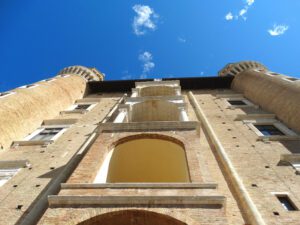The best travel experiences in Italy
What Region is Urbino in? Discovering the Hidden Gem of the Marche Region
Urbino, a picturesque city steeped in history and culture, is one of the most significant towns in Italy when it comes to the Renaissance period. Although it might not be as well-known internationally as Florence or Rome, Urbino’s artistic and historical legacy is immense. But before diving into its rich past, one crucial question arises: What region is Urbino in?
In this article, we will explore the fascinating city of Urbino, its geographical location, and why it is a must-visit destination in the Marche region of Italy. Whether you’re planning a trip to Italy or simply curious about the country’s lesser-known treasures, this guide will provide all the information you need to understand the historical and cultural significance of Urbino and its surrounding area.
1. What is Urbino?
1.1 A Brief Introduction to Urbino
Urbino is a small but historically significant city located in central Italy. Despite its modest size, Urbino boasts a rich heritage, particularly from the Renaissance period, when it flourished as a major center of culture and art. It is most famously associated with the Montefeltro family, whose influence turned the city into a hub for intellectuals, artists, and philosophers during the 15th century.
1.2 Urbino’s Key Attractions
Urbino is home to several remarkable landmarks, including the Palazzo Ducale (Ducal Palace), the birthplace of Raphael, and stunning Renaissance-era architecture. The city’s old town is a UNESCO World Heritage Site, a testament to its importance as one of Italy’s most historically significant towns.
But first, let’s answer the question that many visitors may ask: What region is Urbino in?
2. Urbino’s Location: What Region is Urbino in?
2.1 Urbino: A City in the Marche Region
Urbino is located in the Marche region of central Italy. The Marche region, known for its rolling hills, charming medieval towns, and beautiful coastlines along the Adriatic Sea, offers a unique blend of natural beauty and cultural heritage. Urbino, nestled in the Apennine Mountains, lies in the northern part of Marche, close to the border with Emilia-Romagna.
The Marche region is often overlooked by international tourists in favor of more famous areas like Tuscany or Lazio, but it is an undiscovered gem for travelers seeking authentic Italian experiences, rich history, and unspoiled landscapes.
2.2 The Significance of Marche Region
The Marche region is often referred to as the “the real Italy,” offering travelers the chance to experience a quieter, less touristy side of Italy. Marche is diverse, offering visitors everything from rolling hills and medieval hilltop villages to pristine beaches along the Adriatic coast. Urbino stands out as one of the region’s most historically important cities, combining stunning architecture with a deep connection to Italy’s Renaissance heritage.
Urbino’s geographical location is key to understanding its development. Situated in the fertile hills of the Montefeltro Valley, the city’s position made it a strategic hub during the Middle Ages and Renaissance. The surrounding landscape, with its fertile soil, was perfect for agriculture, while the hills provided natural defense from potential invaders.
3. The History of Urbino and Marche
3.1 Urbino’s Rise to Prominence
The history of Urbino is intertwined with that of the Montefeltro family, who ruled the region for centuries. Under the leadership of Federico da Montefeltro, the city flourished and became one of Italy’s most important Renaissance courts. Federico’s patronage of the arts, education, and intellectual life turned Urbino into a beacon of culture and a center for Renaissance learning.
3.2 The Renaissance Influence on Urbino
The Renaissance’s influence on Urbino cannot be overstated. It was during the reign of Federico da Montefeltro that the city became a haven for artists like Piero della Francesca, who painted his famous “Duke and Duchess of Urbino” portrait. The Palazzo Ducale, still standing today, is a stunning example of Renaissance architecture, showcasing the elegance and intellectual spirit of the era.
While Urbino’s Renaissance heritage is undoubtedly significant, the broader Marche region also played an important role in Italy’s cultural evolution. The Renaissance in Marche gave rise to renowned artists, scholars, and philosophers, contributing to the flourishing of art, science, and humanism during the period.
4. The Marche Region: A Travel Destination for Culture and Nature
4.1 What to See in Marche Region
Marche, often referred to as Italy’s best-kept secret, offers a unique blend of natural beauty, medieval villages, and Renaissance history. While Urbino is the region’s crown jewel, there is so much more to discover in Marche. Some of the must-visit destinations include:
- Ancona: The region’s capital, located on the Adriatic Sea, known for its historic port and charming old town.
- Ascoli Piceno: Famous for its Piazza del Popolo, one of the most beautiful squares in Italy.
- Loreto: A pilgrimage site famous for the Basilica della Santa Casa, which houses the Holy House of Mary.
- Sirolo and Numana: Coastal towns known for their stunning beaches and the natural beauty of Monte Conero.
4.2 Outdoor Adventures in Marche
The Marche region is also a paradise for nature lovers. With its rolling hills, rugged mountains, and beautiful coastline, Marche offers a wide range of outdoor activities, including hiking, biking, and beach trips. For those who enjoy exploring Italy’s natural landscapes, Monte Sibillini National Park is a must-visit, offering dramatic views and opportunities for outdoor exploration.
5. The Culinary Delights of Marche
5.1 Marche Cuisine
Italian food is renowned worldwide, and Marche has its own culinary traditions that set it apart from other regions. Marche’s cuisine reflects the agricultural richness of the region, with a focus on fresh, local ingredients. Some key dishes to try in Marche include:
- Brodetto: A traditional seafood stew made with fish from the Adriatic Sea.
- Olive all’Ascolana: Stuffed olives from Ascoli Piceno, often fried and served as an appetizer.
- Vincisgrassi: A rich, hearty lasagna that’s a regional specialty.
- Ciauscolo: A soft, spreadable sausage that is typical of the Marche region.
5.2 Wine and Olive Oil in Marche
Marche is home to some of Italy’s best wines, including the celebrated Verdicchio and Sangiovese varieties. The region’s olive oil is also of exceptional quality, often made from local varieties such as Ascolana Tenera. Whether you are visiting a vineyard for a wine tasting or enjoying a meal in a local trattoria, the food and drink of Marche are sure to leave a lasting impression.
6. How to Get to Urbino and Explore the Marche Region
6.1 Getting to Urbino
Urbino is well-connected by road to major cities in Italy. The nearest large cities are Ancona, Pesaro, and Urbino, all of which are accessible by car or bus. For international travelers, Ancona and Bologna have airports with flights from major European destinations.
Once in Urbino, visitors can explore the city on foot, wandering through its medieval streets and visiting the many historic landmarks. For those wishing to explore the surrounding Marche region, there are guided tours available, and private transportation services can be arranged for a more personalized experience.
6.2 Private Tours and Transfers in Marche
If you’re looking to explore Urbino and the Marche region in depth, private guided tours are an excellent option. A local expert can take you on a journey through the city’s history, culture, and art. You can also arrange private transfers to other cities in the Marche region, such as Ancona, Pesaro, or Ascoli Piceno, allowing you to experience the region at your own pace.
7. Conclusion: Why Visit Urbino and Marche?
7.1 Urbino: A Hidden Renaissance Gem
Urbino’s rich history, stunning Renaissance architecture, and intellectual legacy make it a must-visit destination for history enthusiasts, art lovers, and travelers seeking an authentic Italian experience. The city’s position in the Marche region adds to its charm, offering a perfect balance of culture, nature, and culinary delights.
Whether you’re planning a short trip to explore Urbino’s landmarks or a more extended journey through the Marche region, there is something for every traveler in this beautiful part of Italy.
Book your Urbino private tour
You might also be interested in:
Where is Urbino, Italy? A Complete Guide to the Location, History, and Travel Tips
Private Transfer Service NCC Rental Taxi: The Complete Guide to Traveling with Comfort and Style
Private Guide Urbino: Your Ultimate Guide to Exploring the City
Things to Do in Urbino: A Complete Guide to Italy’s Hidden Gem
Urbino, Italy: All You Must Know Before You Go
Servizio Privato Transfer/Noleggio NCC Taxi: La Guida Completa per Viaggiare con Comfort e Stile
Guida Turistica Urbino: Scopri la Perla del Rinascimento Italiano
Cose da Fare a Urbino: Guida Completa per Scoprire la Città Rinascimentale
Le Migliori 10 Cose da Vedere a Urbino: Una Guida Completa alla Scoperta della Città
Quanto Tempo Ci Vuole per Visitare Urbino? Guida Completa alla Scoperta della Città
https://en.wikipedia.org/wiki/Urbino
https://whc.unesco.org/en/list/828/
https://edition.cnn.com/travel/article/urbino-renaissance-town-italy/index.html



